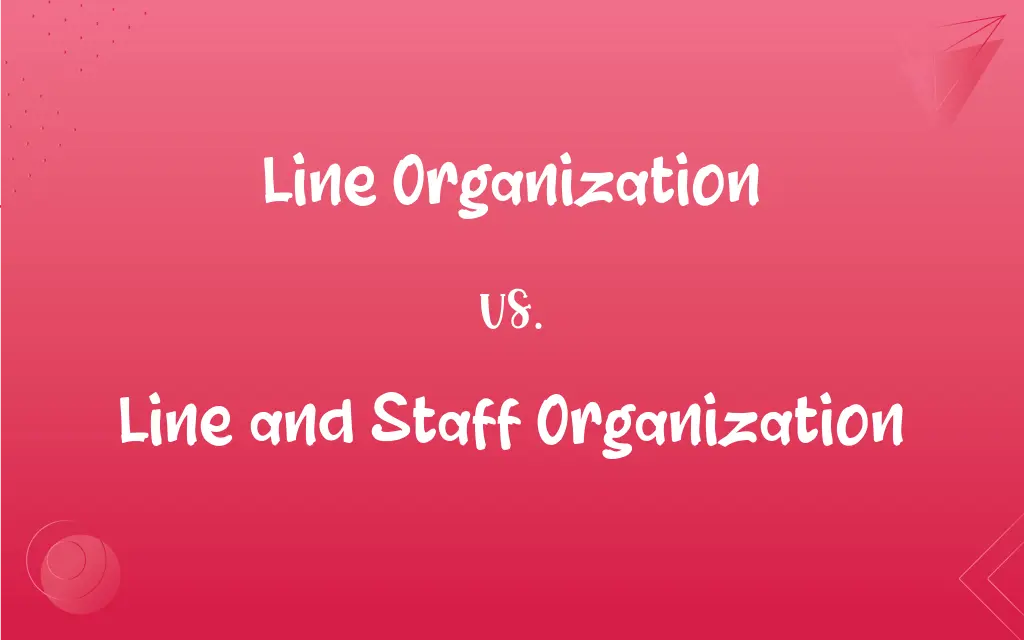Line Organization vs. Line and Staff Organization: What's the Difference?
Edited by Aimie Carlson || By Janet White || Published on February 8, 2024
Line organization is a simple structure with direct, vertical relationships, while line and staff organization combines direct line authority with specialized staff support roles.

Key Differences
Line organization is characterized by its simplicity and direct chain of command. It follows a straight line of authority from top management to the lowest ranks. This structure is straightforward, with each employee having a clear superior. Line and staff organization, however, is more complex, combining the line structure with specialized staff roles that provide support and advice. This structure adds a layer of expertise without altering the direct line of authority.
In line organizations, decision-making is often quicker due to the clear and direct lines of authority. Managers in line roles are solely responsible for the decisions and operations within their departments. In line and staff organizations, decision-making involves inputs from both line managers and staff advisors. This can lead to more informed, but potentially slower, decision-making processes due to the need for consultation and integration of expert advice.
Line organizations are typically more rigid and less adaptable to change, as they lack specialized roles. This structure works well in smaller or less complex operations where high levels of specialization are not required. Line and staff organizations, on the other hand, offer greater flexibility and access to specialized knowledge. Staff roles provide expert advice and support, allowing the organization to adapt more readily to changes and complex challenges.
In line organizations, authority and responsibilities are clearly defined and limited to the direct line of command. Each manager or employee is accountable for specific tasks related to their position. In contrast, line and staff organizations have a dual system where line managers handle core business activities while staff positions provide specialized support, advice, and services that extend beyond the regular line functions.
Line organizations are suitable for smaller businesses or those with simple operational processes, where efficiency and direct control are paramount. Line and staff organizations are better suited for larger, more complex businesses where specialized skills and advisory roles are needed to support the line managers and enhance decision-making and operational efficiency.
ADVERTISEMENT
Comparison Chart
Structure
Simple, direct chain of command
Complex, combines direct authority with staff roles
Decision-making
Quick, direct decisions
Slower, involves consultation and expert advice
Flexibility and Specialization
Less flexible, minimal specialization
More flexible, includes specialized staff roles
Authority and Responsibilities
Clear, confined to line of command
Dual system with line authority and staff advice
Suitability
Small/simple businesses
Larger/complex businesses
ADVERTISEMENT
Line Organization and Line and Staff Organization Definitions
Line Organization
Direct and straightforward organizational structure.
The small startup thrived with a line organization, ensuring quick decision-making.
Line and Staff Organization
Combines direct line management with specialized staff support.
The corporation adopted a line and staff organization to include expert advisors in decision-making.
Line Organization
Clear chain of command from top to bottom.
In the line organization, every employee knew exactly who their supervisor was.
Line and Staff Organization
Includes both direct authority and advisory positions.
In their line and staff organization, HR staff provided essential support to operational managers.
Line Organization
Each manager has direct control over their subordinates.
In their line organization, department managers had full authority over their teams.
Line and Staff Organization
Integrates line managers with staff experts for better decision-making.
The line and staff organization enabled IT experts to advise the production department.
Line Organization
Simple hierarchy with direct reporting relationships.
The factory’s line organization allowed for efficient and clear communication.
Line and Staff Organization
Provides specialized support without disrupting direct authority.
The line and staff organization balanced the need for direct control with access to financial expertise.
Line Organization
Emphasizes direct supervision and clear responsibilities.
The line organization's structure was perfect for the company's straightforward operational model.
Line and Staff Organization
Merges clear chain of command with expert advice roles.
Their line and staff organization allowed for specialized marketing staff to support sales managers.
FAQs
Is decision-making faster in line organizations?
Yes, due to the straightforward chain of command.
What advantage does a line and staff organization have?
It offers specialized support alongside direct management.
What is the main benefit of a line organization?
Clear authority and quick decision-making.
How do staff roles in line and staff organizations contribute?
They provide expert advice and support.
Do line organizations require specialized roles?
No, they focus on direct management without specialization.
Are line organizations suitable for large businesses?
They are less suitable due to their simplicity.
Are line organizations good for complex industries?
They might struggle due to lack of specialization.
Can line and staff organizations adapt better to change?
Yes, thanks to their specialized staff roles.
What is a line organization?
A simple structure with a direct chain of command.
How does a line and staff organization differ?
It combines line management with specialized staff roles.
Do line organizations have staff advisors?
No, they consist only of direct management roles.
Can a small business use a line and staff organization?
It's possible but may be more complex than needed.
How does communication flow in a line organization?
Vertically and directly from top to bottom.
Are line organizations easy to manage?
Yes, due to their simplicity and clear structure.
How does a line and staff organization handle complex tasks?
Through collaboration between line managers and staff advisors.
What is the key to success in a line and staff organization?
Effective integration of line authority with staff expertise.
Does a line and staff organization facilitate better planning?
Yes, with input from specialized staff.
Is training important in a line and staff organization?
Yes, for both line managers and specialized staff.
Can a line organization be transformed into a line and staff organization?
Yes, by introducing specialized staff roles.
Do line organizations support rapid growth?
They may be limiting due to their lack of specialized roles.
About Author
Written by
Janet WhiteJanet White has been an esteemed writer and blogger for Difference Wiki. Holding a Master's degree in Science and Medical Journalism from the prestigious Boston University, she has consistently demonstrated her expertise and passion for her field. When she's not immersed in her work, Janet relishes her time exercising, delving into a good book, and cherishing moments with friends and family.
Edited by
Aimie CarlsonAimie Carlson, holding a master's degree in English literature, is a fervent English language enthusiast. She lends her writing talents to Difference Wiki, a prominent website that specializes in comparisons, offering readers insightful analyses that both captivate and inform.







































































